
Becky Gillaspy
College instructor of the science of nutrition for 10 years. I teach weight loss strategies that are easy-to-follow, enjoyable, and effective.
Recent Posts
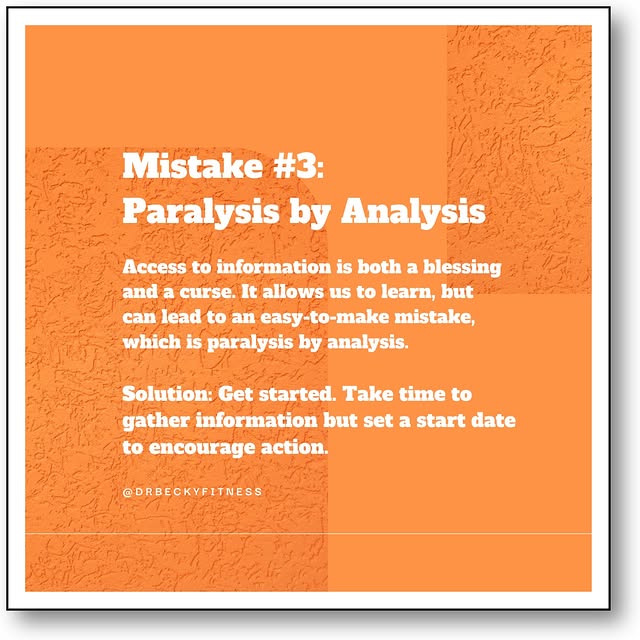
Go SUGAR-FREE for 1 Week Mistake #3: Paralysis by Analysis We live in a time when information is easy to access. Whatever goal you want to achieve or project you want to tackle, there’s a video or article on that topic. In fact, there are likely hundreds, maybe thousands. Access to all of this information is both a blessing and a curse. It allows us to learn, but can lead to an easy-to-make mistake, which is paralysis by analysis. Solution: Get Started Whenever you start something new, you need to go through a learning process. But at some point, you need to shift from gathering information to taking action. Think about learning how to drive a car. First, you gathered information by taking a driver’s education course and watching your parents drive. Those were necessary steps, but at some point, you needed to sit down behind the wheel and drive. You made mistakes, but are likely pretty comfortable with driving now because you learned by doing. Changing your diet is no different. Take time to gather information and stock your hunger survival kit, but don’t forget to set a start date to encourage action. Excerpt From: Go SUGAR-FREE for 1 Week – Here’s The Plan
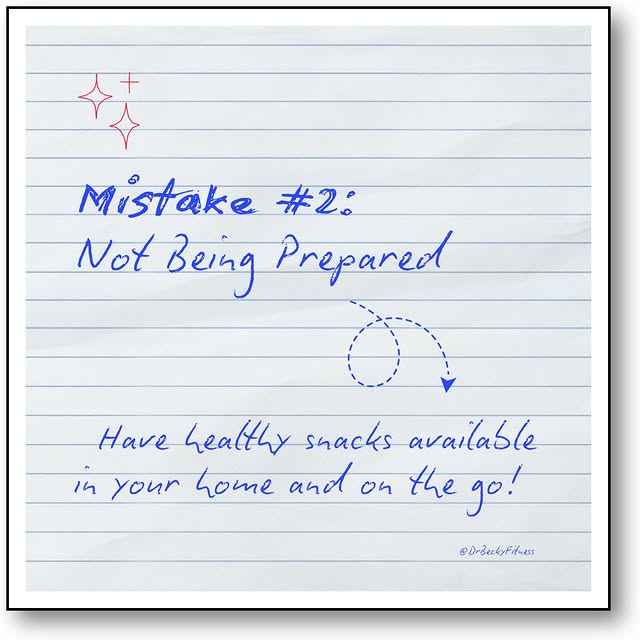
Go SUGAR-FREE for 1 Week Mistake #2: Not Being Prepared Giving your body what it needs today also means being prepared for the day. When life gets stressful, we want comfort and convenience. If you do not have satisfying, easy-to-grab healthy snacks available, it is too easy for emotions to take over, and good judgment flies out the window. Solution: Create a Hunger Survival Pack In my book, Zero Sugar / One Month, I talk about creating a hunger survival pack by gathering ready-to-eat, low-carb foods that contain protein and fat. This combination of nutrients stabilizes blood sugar, preventing crashes that drive cravings. If you travel during the day, you can make a physical hunger survival pack by placing shelf-stable foods, like raw or lightly toasted nuts, individual packets of almond butter or natural peanut butter, and beef sticks, into a portable bag. But you don’t need an actual pack. You can collect healthy items on a shelf in your refrigerator. Then, when hunger hits, eat. Here are some suggestions: Deviled eggs, precooked meats, presliced cheese, cut veggies with full-fat dip or cream cheese, full-fat yogurt or cottage cheese with berries, stuffed olives, and kimchi. By stocking up on these easy food choices before starting your sugar-free week, you are helping your body transition from quick-energy foods to ones that sustain energy over time. It takes effort to make that transition, so you must help your body through by feeding it. Excerpt From: Go SUGAR-FREE for 1 Week – Here’s The Plan

Go SUGAR-FREE for 1 Week Mistake #1: An All-Or-Nothing Approach The goal is to get sugar out of your diet. When you set a goal, it is important to have boundaries and strictly adhere to those boundaries; otherwise, you just spin your wheels and never make progress. Yet, as I mentioned, you can have fruit and noncaloric sugar substitutes during your sugar-free week. For some of you, that seems like too much wiggle room. However, I would argue that avoiding sugar is a unique goal because there’s a mix of biological, psychological, and social components that must be dealt with. Therefore, having an all-or-nothing mindset from the start works against the completion of your goal. Along that same line, when motivation hits, it is common to grow a singular goal, like avoiding sugar for one week, into a multi-prong goal. Instead of just reducing sugar, we also reduce our overall food intake, start fasting, and add intense exercise. There is nothing wrong with those practices, and as time passes, they add to your progress. But if you push your body too quickly, it will push back—and it has some powerful weapons, including cravings, hunger, and fatigue. Instead of forcing change, allow change to happen by giving your body what it needs to succeed. Your goal for this week is to avoid added sugar. If hunger arises, give yourself permission to eat. When you eat a meal, fill your stomach so you can delay hunger and keep your attention off food. Don’t focus on calories at this point. That is fine-tuning. When your body has adapted to your new sugar-free diet, hunger will diminish naturally. In other words, give your body what it needs today, and it will give you what you want tomorrow. Excerpt From: Go SUGAR-FREE for 1 Week – Here’s The Plan
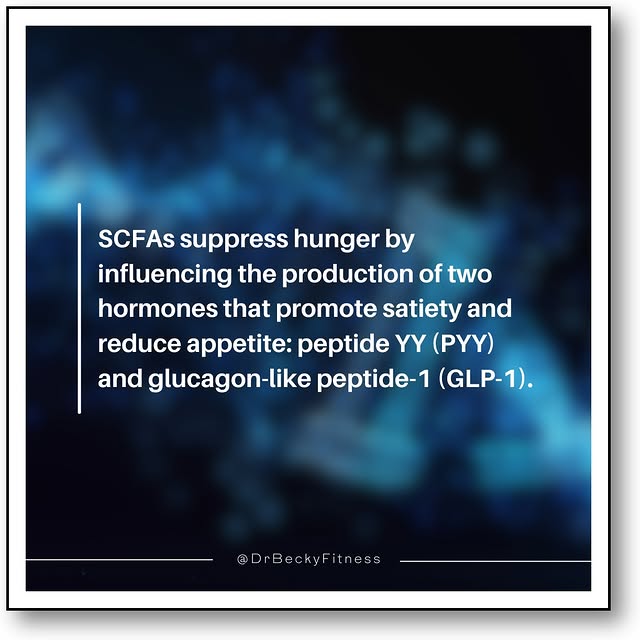
How SCFAs Suppress Hunger: Factor #1: Boost Satiating Gut Hormones Short-chain fatty acids suppress hunger by influencing the production of gut hormones. Specifically, they stimulate the release of two hormones that promote satiety and reduce appetite, peptide YY (PPY) and glucagon-like peptide-1, which commonly goes by its abbreviation GLP-1. Now, if that name rings a bell, it is because of the sudden popularity of weight loss drugs like Ozempic. Ozempic is a GLP-1 agonist, meaning it mimics the action of this naturally occurring hormone, enhancing its effects. There is more to the hunger-suppressing ability of short-chain fatty acids that has yet to be unraveled. One factor that likely plays a role is their interaction with the gut-brain axis. Excerpt From: SCFAs SUPPRESS HUNGER – Here’s How To Get Your Body To Make Them
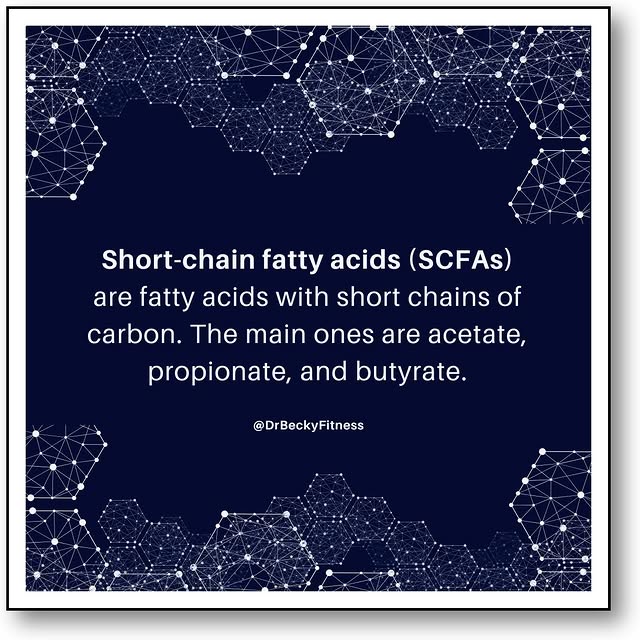
What Are Short-Chain Fatty Acids? Short-chain fatty acids, as the name suggests, are fatty acids with short chains of carbon, either two carbons, three carbons, or four carbons. They are produced in your gut by the fermentation of fiber. The three short-chain fatty acids that make up 95% of these molecules are acetate, propionate, and butyrate: C2, C3, and C4. They act as an energy harvest system for undigestible carbohydrates, and some animal species actually use this as a major source of energy. For example, lowland gorillas get about 57 percent of their energy from short-chain fatty acids. We think about these enormous animals, and they’re vegetarians. How does that work? How do they get that much energy from plant foods? Their gut bacteria have a high capacity for turning undigested carbohydrates into these energy-rich molecules. Humans also have that ability, but we cannot derive as much energy from plant foods. Only 1.2 – 10% of a human’s energy comes from SCFAs. Still, as I touched on at the start of the video, SCFAs support metabolic health and weight control in many ways. SCFAs Metabolism Benefits: Suppress Appetite Enhance Insulin Sensitivity Promote Fat Oxidation Increase Energy Expenditure Reduce Inflammation Support Gut Health Regulate Fat Metabolism For this blog post, I want to focus on how they help us eat less. Excerpt From: SCFAs SUPPRESS HUNGER – Here’s How To Get Your Body To Make Them

Boring Diet Solutions With so many traps laid for us in the food environment, following a boring diet will not only help you reach your health goals, but you’ll also find it to be quite freeing, saving you time, helping you feel better about what you and your family are eating, and bringing cravings under control. Here are some practical ways to bring boredom into your diet. Repeat Meals A great first step is repeating meals. Here are two things you can do this week. First, eat the same thing for breakfast and lunch each day. A simple, repetitive menu is easy to follow, saves you time and food prep, and keeps you in control of your eating. For example, eat an omelet for breakfast, eat a salad for lunch, and repeat. Second, make it a goal this week to find two dinner recipes that are easy to make, enjoyable, and made from whole food ingredients. A ten-minute Google search will give you plenty of recipes. For example, Google “show me low-carb chicken recipe using a crockpot.” If you do this for a few weeks, you will have five to ten favorite recipes that you can rotate, reducing decision fatigue and keeping you out of restaurants. Eat at Home Restaurants are designed to encourage continuous eating. They provide a range of flavors and textures that keep stimulating your appetite. Going out to eat is an enjoyable activity, so you don’t need to write it off completely. However, you’ll be happiest with your results if you make going to a restaurant a special occasion rather than a daily indulgence. Eat Protein and Fat with Each Meal Protein and fat take time to digest, keeping hunger away for hours and cravings under control. There are many foods to build a meal around, including meat, fish, eggs, cheese, nuts, and seeds. Visit my blog post to learn more: Stop Your Intake of Toxic Foods – Why “Boring” is Better
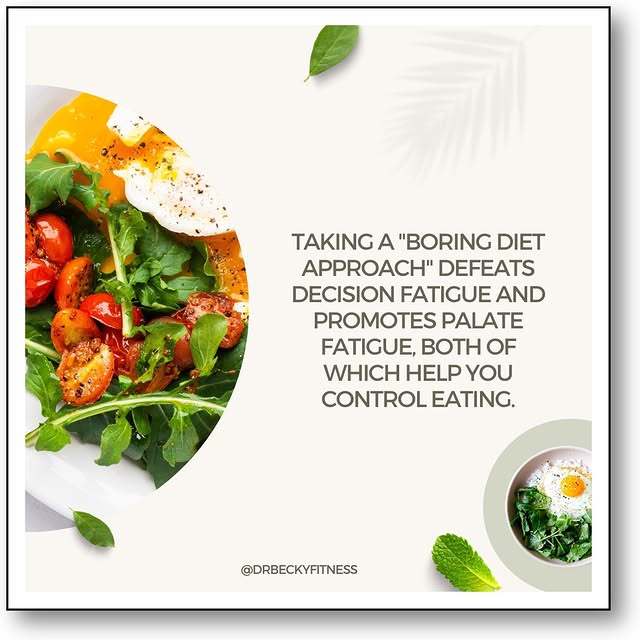
Boring Diet Benefits “Boring” doesn’t mean eating a diet void of flavor. Instead, it means repeating meals and enjoying what you eat but limiting variety within a meal. By doing this, you defeat decision fatigue and promote palate fatigue. Boring Benefit #1: Defeats Decision Fatigue Having a variety of appealing food choices readily available encourages overeating. Keeping these foods out of sight and out of reach not only helps prevent overeating but also reduces reliance on willpower, which can be easily depleted by daily stressors like low blood sugar, fatigue, and stress. Decision-making is one of the most exhausting and stressful activities we engage in, and this constant burden leads to decision fatigue (2). Willpower is no match for decision fatigue, and when it sets in, it becomes difficult to control behaviors like eating. Boring Benefit #2: Promotes Palate Fatigue Keeping things boring also directly counters sensory specific satiety by promoting palate fatigue. Palate fatigue is sometimes referred to as taste bud exhaustion because it occurs when your taste buds become so accustomed to a particular taste or texture that the food is no longer appealing. An episode of “Man vs. Food” perfectly illustrates this. In the episode, the host was challenged to eat an enormous sundae in under an hour. Halfway through, he started to struggle, so what did he do? He asked for an order of crunchy, salty french fries. Why would he do that? He understood palate fatigue and knew that the sameness of the ice cream’s taste and texture was shutting down his appetite. He purposely shut down palate fatigue by temporarily switching to a food that had a different taste, texture, and temperature. This restimulated his appetite, and he was able to finish the ice cream challenge. Visit my blog post to learn more: Stop Your Intake of Toxic Foods – Why “Boring” is Better

We Are Wired to Eat Toxic Foods: Sensory Specific Satiety But why does having a variety of foods in front of us make us want to keep eating? This can be explained by understanding sensory specific satiety. It refers to the declining satisfaction we get from eating a particular type of food and the subsequent increase in appetite that we get when we switch to a new taste or texture. When you eat, you feed your body and your senses. Foods vary in many ways, from taste to texture to aroma. The trap of sensory specific satiety is that it keeps renewing your appetite even though your body has no need for more food. This explains “The Dessert Effect,” where, despite feeling full, we find room for dessert. The anticipation of the cake’s taste and texture overrides your brain’s satiety cues. As we can see, the issues with our food supply are complex, and it’s challenging to pinpoint a single solution. However, limiting variety and opting for “boring” meals might be an answer to overconsumption. Visit my blog post to learn more: Stop Your Intake of Toxic Foods – Why “Boring” is Better
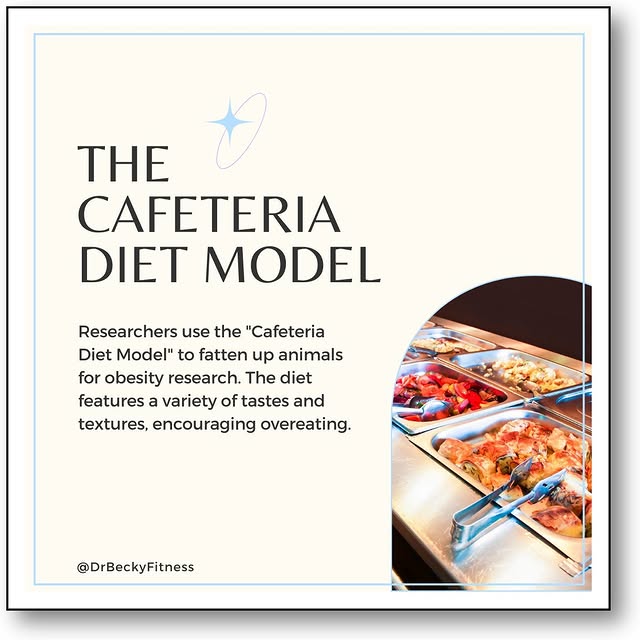
We Are Wired to Eat Toxic Foods: Variety When you remove toxic ingredients from your diet, you make great strides toward better health. The challenging thing is that we are wired to want to eat them, and that desire is driven by two factors: variety and a phenomenon known as sensory specific satiety. It is said that variety is the spice of life, but when it comes to eating, having too many choices stimulates your appetite. There is no better illustration of this than “The Cafeteria Diet Model” used in obesity research. To study obesity, researchers need obese mice. To fatten up animals quickly, they give them a variety of foods, much like humans encounter at a cafeteria. This smorgasbord of different food choices overrides hunger-satisfaction cues and encourages effortless overeating. Visit my blog post to learn more: Stop Your Intake of Toxic Foods – Why “Boring” is Better

Toxic Food #1: Sugar No matter what style of eating you prefer, from vegetarian to keto, if your goal is better health and weight loss, sugar is the first thing to go for good reasons. Consuming sugar throughout the day promotes high blood sugar and insulin levels that are inflammatory and encourage fat storage. A high intake of fructose, which is a common sugar found in soda and processed foods, causes fat to accumulate in the liver, significantly increasing the risk of non-alcoholic fatty liver disease (NAFLD). How to Reduce Sugar I have blog posts on how to cut sugar out of your diet and a book, Zero Sugar / One Month, that you can pick up on Amazon. But the general rule is this: If a packaged food has sugar listed as one of the first three ingredients, don’t eat it. That does not include natural sugar from fruit and other whole foods because they contain nutrients that slow digestion. Visit my blog post to learn more: Stop Your Intake of Toxic Foods – Why “Boring” is Better
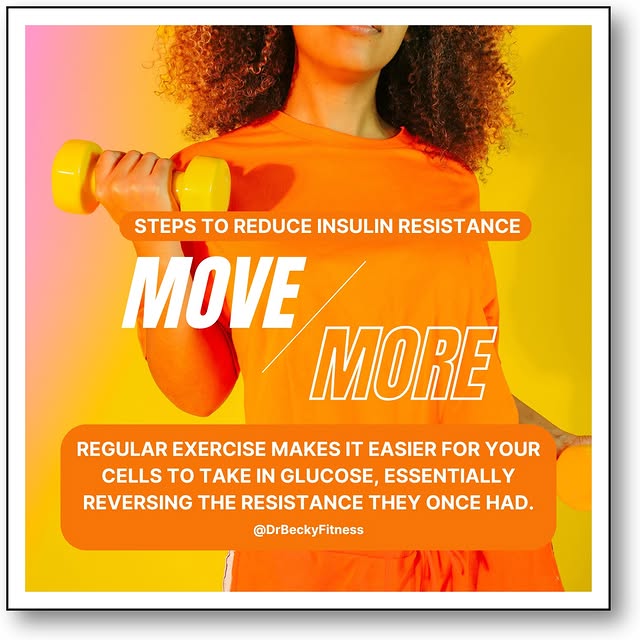
Steps to Reduce Insulin Resistance: Solution #3: Move More Regular exercise makes it easier for your cells to take in glucose, essentially reversing the resistance they once had. The nice thing is that all forms of exercise have been shown to help, so whether you enjoy aerobic-style exercises like walking or riding a bike or you prefer lifting weights at the gym, you will benefit, and if you do a combination of exercises, you’ll boost your benefits even more. Visit my blog post to learn more: How Insulin Resistance Affects Your Weight Loss Journey
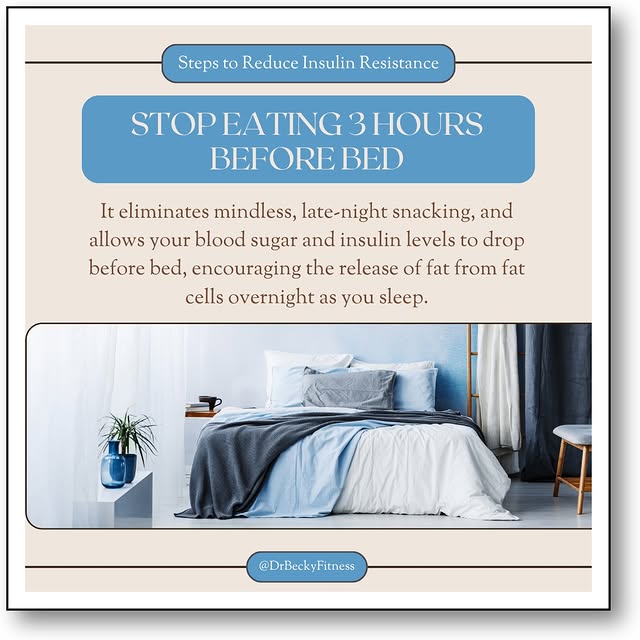
Steps to Reduce Insulin Resistance Solution #2: Stop Eating 3 Hours Before Bed Creating the daily habit of stopping eating 3 hours before bed gives you two weapons against insulin resistance. First, it eliminates mindless, late-night snacking, which tends to include sugary drinks and refined foods. Second, it allows your blood sugar and insulin levels to drop before bed, encouraging the release of fat from fat cells overnight as you sleep. Visit my blog post to learn more: How Insulin Resistance Affects Your Weight Loss Journey
Similar Influencers

Sugar Jones 🤘🏽

SS Poct LLP

Blessings for Your Soles

SENTHILKUMAR SELVARAJ

DiabetesTipsRecipes 💚

Parveen Kalra

ratih azhar

JAG Naturals , LLC

Gian Frabotti

Rival Clothing

Suzanne Budzich

Simon

Voces Diabetes Colombia

Diabetes Self-Management

Women Fitness | Fitness Training | Home Workout & Weight Loss

The Diabetes Support Group

Diabetes Books

Pryceless Creations Clothing

Kunal Panchal | REALTOR®

The Type 1 Pal

Heroic Italian

Pardon My Pancreas Podcast
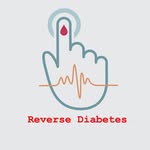
Reverse Type2 Diabetes Natural

Brook🍯🦋

Diversity in Diabetes

Diabetic Life | Diabetes Diet

Achsah✨

Mama Ibado Charity

Appleby Pharmacy
